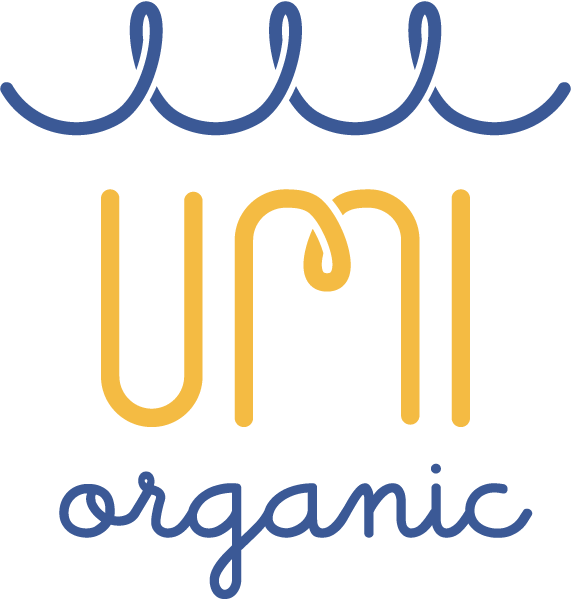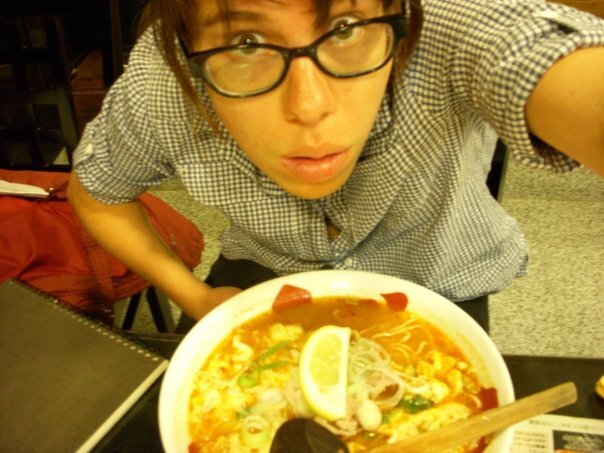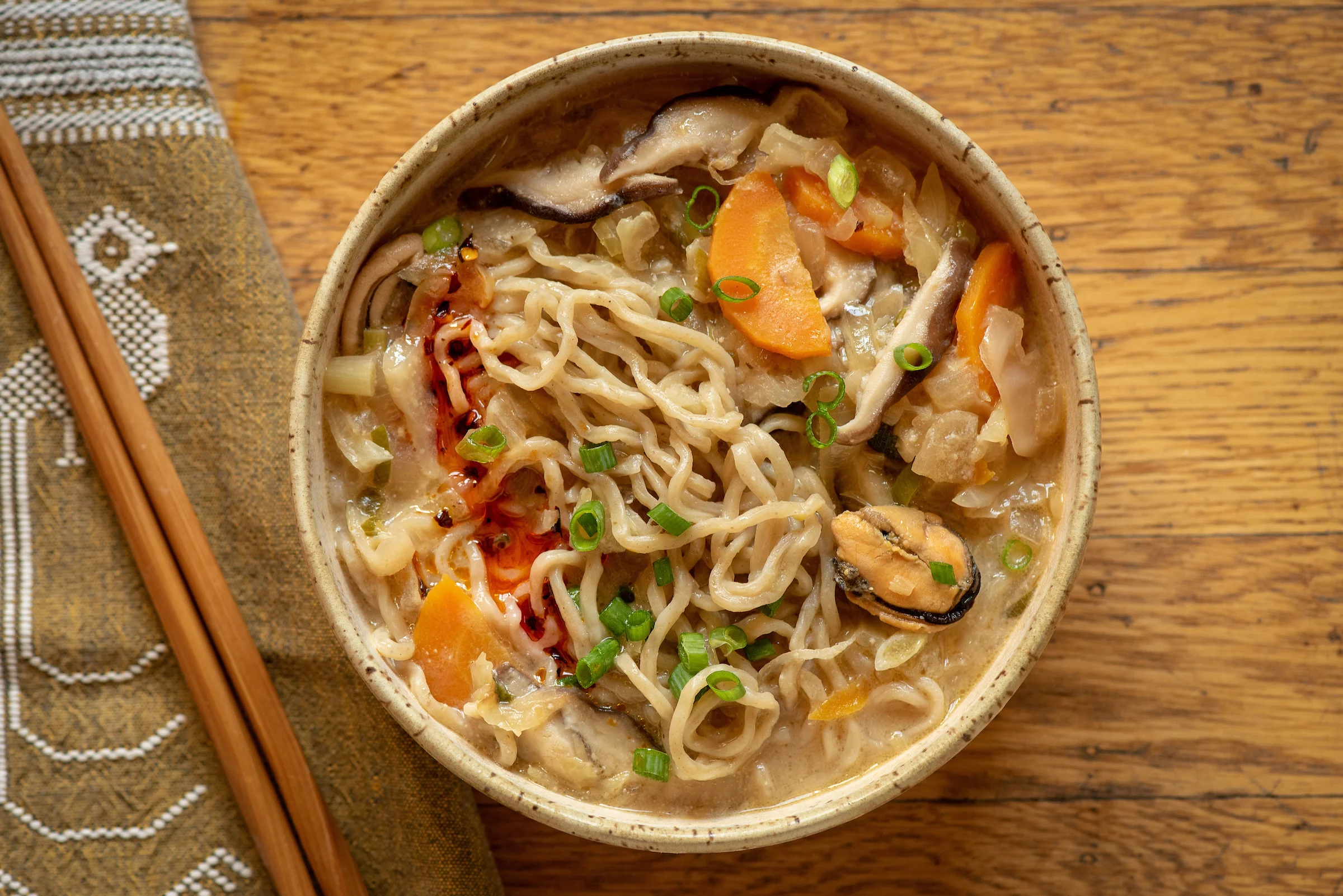By Lola Milholland
I have been thinking about how in the world Umi came to be. There are a lot of ways to tell this story, of course, but one route might be called “Ramens I Have Loved.” I was surprised to discover while going through old photos how many ramen photos I took during the one year I lived in Japan and then subsequent visits. During one especially long stay when I was 23, I travelled from Tokyo to Aomori to Niigata and then to Kyoto, my chosen second home. For around one month, I slept on friends’ floors, kept house, cooked us dinner, and during the day wandered the streets led by my eyeballs and nose, waiting for lunchtime when I would eat noodles. I was at an age when a lot of friends were getting masters’ degrees, and a friend joked that I was majoring in hot springs and minoring in ramen.
This photo was taken as I took local trains from Aomori, where I stayed with my friend Dana who was working for the prefectural government, down to Niigata, where I embedded myself in my former host sister Tomoko’s graduate program for food studies by making her students take me everywhere. En route, I had a stop overnight, and I landed on Japan’s west coast in the small city of Tsuruoka. When I got off the train, I began wandering in the dark. I remember the night streets were empty and it was very cold. This was the spring of 2009, immediately following the financial crisis that bludgeoned the economy. I remember puzzling at a shabby building with an overly lit sign that read AIG, the insurance giant that had so recently collapsed and that I had never heard of until its demise. Everywhere I went that spring, the financial crisis seemed to be trailing me, taunting me. I wouldn’t have put these words on it then, but I experienced the Great Recession as though it were an invisible volcano that had erupted, pouring transparent lava around my feet and the feet of all my friends. It didn’t kill us; it simply cemented us in place. We felt unsure of what to do next given the scarcity of jobs and shocked that something we had never even heard of—subprime mortgages—and a bunch of greedy bankers with no moral compass a thousand miles away were immobilizing us. We could look, wiggle, and scream, but we could not move forward. That spring, I felt unsure of myself and powerless, but looking back I can see that I did have a purpose on that walk by myself. To find ramen.
Gojunoto (五重塔) five story pagoda on Mt. Haguro.
The ramen spot I came upon had a rural auntie style that I associate with women in Japan wearing really plentiful aprons. It was a ramen shop, but not in the masculine (dare I say Bro-y) way many are. Instead, it was brightly lit and homey. I remember they leaned heavily into gimmicky toppings like Kewpie mayo and natto. I ended up with a bowl of spicy miso ramen that was so delicious and comforting that I almost felt like it walked me to my hostel and tucked me into bed. The noodles were medium-thin and a little wavy, like a Tokyo noodle without the harsh yellow, and the broth was rich and seafoody. That said, I remember this bowl of ramen less as a food than as a balm. It soothed me enormously and transcended the material to become something else entirely—an anchor memory of being alone but safe.
The next day, I climbed Mt. Haguro—through a grove of 600-year-old sugi trees, past a beautiful five-story pagoda and a 1,000-year-old cedar tree known as Grandpa cedar, and up 2,446 stone steps. When I reached the top, there was a restaurant where you could eat zenzai (mochi in an adzuki bean soup) and a monastery where monks seemed to be living their lives in a pleasantly everyday way, taking no notice of us.
From there, I travelled to Niigata to meet my former host sister. One of the first questions her students asked me when I arrived was what “Forever 21” meant. A flagship store had just opened in the prefecture and they were all obsessed. They had bought stripped shirts that were ripped and trailed to their mid-thighs and blousy dresses that seemed especially impermanent. I thought about it for a moment and then offered my interpretation: It meant that when you wore their clothes, you transformed into a 21 year old. The clothes were a time machine. We all laughed because we saw how funny it was to make that impossible promise, but also that as 21 (and 22 and 23) year olds, we were being sold the idea of ourselves. Somehow, without our doing anything, we had already reached some peak. So how come we were dissatisfied? During the rest of my time in Niigata, whenever we parted, my friends and I would all excitedly scream, “Fo-re-ba tchu-en-chi-wa-nuuuuu,” the elongated way of pronouncing the English words “Forever 21” in Japanese, lingering on the last syllable, “oooooo,” like only a real 21 year old would. I could never tell if we had commandeered the joke and were inside it, or if the joke was somehow still on us.
My friends Chika and Haruka.
The Great Recession caused me to stay in the first job I got after college and stay put in my hometown. The combo had a concentrating effect on my personality. I was like a broth simmering on the stove, becoming more and more condensed. My interest in ramen and Japanese food culture kept taking up a larger and larger share of my mind—the salt that stays as the water evaporates. This one bowl of ramen in Tsuruoka is not the only bowl of soup that led me here today. But I remember it and all the moments around it sharply. I was becoming who I am, learning what I love, what brings me comfort, and how to care for my friends in an unpredictable and often brutal world. I have come to wonder: Is ramen my forever 21, my time machine?














